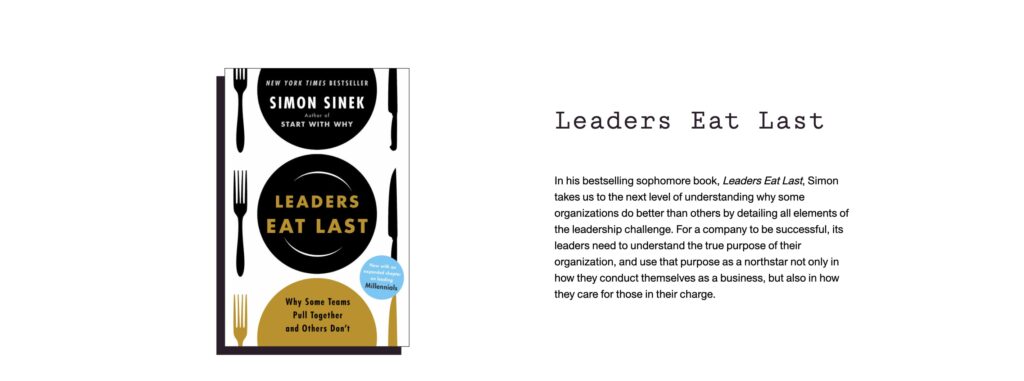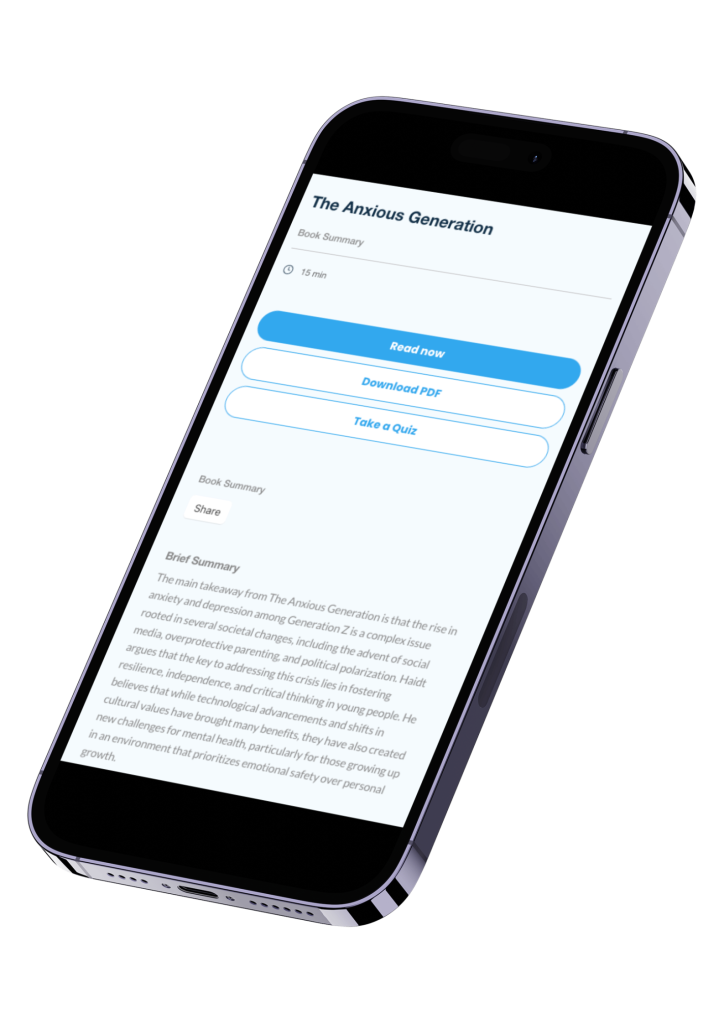If you’re looking for a great leadership book, Simon Sinek’s “Leaders Eat Last” is a great read. In this article, I’ll share an exhaustive yet brief “Leaders Eat Last” summary that will help you see for yourself if this book is worth reading.
In “Leaders Eat Last,” Simon Sinek delves deep into the nature of leadership, proposing that the most effective leaders prioritize the well-being of their team members over everything else. Drawing upon real-world examples from both the military and the corporate world, Sinek makes a compelling argument for the type of leadership that builds trust, collaboration, and long-term success.
This isn’t just about leaders in the traditional sense but about the culture of organizations and how they can be designed to bring out the best in their people. Join us as we explore the key insights from this transformative book on leadership.
A Leaders Eat Last Summary
At its core, “Leaders Eat Last” by Simon Sinek is a meditation on the nature and practice of true leadership. Throughout the book, Sinek provides vivid examples from various sectors – including the military, academia, and businesses – to illustrate how leaders who prioritize the well-being of their team members yield better results. Conversely, he also showcases the detrimental effects of leadership that fail to cultivate trust.
In today’s volatile business environment, where short-term gains are often prioritized over long-term loyalty and success, Sinek’s message resonates powerfully: Leaders who eat last, who put their team’s needs before their own, build organizations that dominate their fields and stand the test of time.
The true price of leadership is the willingness to place the needs of others above your own. Great leaders truly care about those they are privileged to lead and understand that the true cost of the leadership privilege comes at the expense of self-interest.
“Leaders Eat Last” by Simon Sinek
The Circle of Safety
Sinek posits that great leaders create a Circle of Safety that encompasses every member of their team or organization. This Circle of Safety means that team members feel safe, valued, and protected, not threatened or expendable.
This sense of safety, according to Sinek, stems from our evolutionary biology. In the animal kingdom, leaders (like alpha wolves) secure the perimeter, ensuring the group is safe from external threats. This same principle, Sinek argues, should be applied in organizations. When employees feel safe from internal politics and confident that their leaders have their backs, they naturally cooperate more effectively and innovate more freely.
Unlock Key Book Insights in 15 Minutes with Sumizeit
Get essential lessons, insights, and strategies with bite-sized book summaries. Sumizeit helps you save time and stay ahead with expert-curated summaries from top business books.
Sign up today and start learning in just 15 minutes a day!
Why Humans Need Safety
Simon Sinek’s “Leaders Eat Last” delves into the profound concept of why humans inherently crave and need safety. Rooted deep within our evolutionary biology, the need for safety is as primal as our need for food or shelter. Early humans thrived in groups, relying on one another for survival against predators and external threats. Within these groups, the role of the leader was to provide security, ensuring the collective well-being of the tribe.
Fast forward to modern times, our “threats” may not be predators in the literal sense, but they manifest in other forms: job security, financial stress, internal politics, and other workplace pressures. However, our primal instincts remain. Sinek underscores the idea that in the workplace, the role of genuine leaders is akin to that of early tribal leaders: to create an environment where team members feel safe from internal and external threats. When this environment is cultivated, it sets the stage for trust, cooperation, and the kind of innovation that propels organizations forward.

The 4 Chemicals that Drive Human Behavior and Motivation
One of the standout aspects of “Leaders Eat Last” is Sinek’s exploration of the biological factors that drive human behavior, especially in the context of leadership and organizational culture. He pinpoints four primary chemicals in our body that play a crucial role in shaping how we feel, act, and interact.
Endorphins
Endorphins are our body’s natural painkillers. They are released in response to physical discomfort or stress, helping to mask pain and discomfort. From an evolutionary perspective, endorphins enabled our ancestors to push through fatigue while hunting or to escape predators despite injuries.
In the modern context, endorphins are responsible for the “runner’s high” that athletes often describe – a sense of euphoria after intense physical activity. In the workplace, endorphins can help us deal with crises.
Dopamine
Dopamine is the “reward” chemical. When we achieve a goal or complete a task, dopamine gives us a hit of pleasure, motivating us to repeat the behavior. It’s the reason we feel satisfied when crossing off tasks from a to-do list or achieving short-term goals.
Dopamine-driven behavior is essential for productivity and progress. But in large doses, we can become shortsighted in our decision-making. Leaders need to strike a balance: while dopamine-driven rewards (like bonuses or promotions) can motivate employees, we should also add long-term rewards in the mix (mission and legacy).
Serotonin
Serotonin is called the “leadership” chemical because it fosters feelings of pride, loyalty, and recognition. When we feel valued and recognized for our contributions, our bodies release serotonin, enhancing our mood and overall sense of well-being.
Leaders who acknowledge and appreciate their team’s efforts tap into this powerful chemical, promoting a culture of mutual respect and recognition. When leaders express genuine gratitude or offer praise, both the giver and the receiver experience a boost in serotonin.
Oxytocin
We release Oxytocin, the “love” or “trust” chemical, during moments of deep connection and bonding – be it between a mother and her child or between close friends. In the realm of leadership, acts of kindness, trust, and human connection stimulate oxytocin release.
Leaders who foster environments where team members genuinely care for one another, where there’s trust and vulnerability, amplify the presence of oxytocin. This leads to a work culture marked by deep trust, loyalty, and a sense of belonging.
Why There’s Imbalance in Society
In “Leaders Eat Last,” Simon Sinek dedicates a portion of his work to exploring the imbalances present in our modern society and organizations. Sinek argues that while human beings are biologically wired to thrive in a balanced environment of trust and cooperation, certain factors in our current society work against this equilibrium.
- Short-term Gain vs. Long-term Health: In today’s business environment, there’s a disproportionate emphasis on short-term results, often at the expense of long-term sustainability. Whether it’s companies prioritizing quarterly earnings over sustainable growth or individuals seeking instant gratification instead of lasting satisfaction, this shortsightedness creates an imbalance.
- Erosion of Community and Trust: In many organizations and communities, there’s a decline in genuine human connection and a sense of belonging. As trust erodes, people feel less secure, leading to more defensive and self-centered behaviors. This erosion is exacerbated by leadership that fails to create a Circle of Safety or prioritizes personal gains over collective well-being.
- Value Shifts: Over the years, societal values have shifted. Many societies today prioritize individual achievements and materialistic success over collective well-being and communal values. This shift further propagates a culture where people often feel isolated, competitive, and less inclined to trust and cooperate.
How to Become a Leader According to Simon Sinek
Simon Sinek’s “Leaders Eat Last” offers profound insights into what true leadership entails and provides a roadmap for anyone aspiring to be a genuine leader. Here are the primary takeaways on how to become a leader according to Sinek:
Put Others First
The book’s title itself encapsulates this principle – “Leaders Eat Last.” Prioritize the well-being, growth, and needs of your team members before your own. This selfless act establishes trust, loyalty, and a commitment to the collective mission.
Create a Circle of Safety
Cultivate an environment where team members feel protected from external threats and internal politics. This safety allows for creativity, innovation, and genuine collaboration, fostering an atmosphere where people feel they can be their authentic selves.
Be Consistent
You don’t build trust overnight. That’s why leaders need to be consistently trustworthy, making decisions and taking actions that align with the team’s best interests. It’s this consistency over time that cements the foundation of trust.
Lead with Empathy
Understand the personal and professional challenges your team members face. Being empathetic allows leaders to connect on a human level, promoting a culture of mutual understanding and respect.
Foster Human Connections
Encourage face-to-face interactions, team-building activities, and open communication channels. These genuine human connections stimulate oxytocin and serotonin, strengthening bonds and fostering collaboration.
Celebrate Achievements, Big and Small
Recognizing and celebrating the achievements of team members not only boosts morale but also reinforces the importance of every contribution towards
Reasons to Read “Leaders Eat Last”
- Universal Lessons: Although the book focuses on leadership, its lessons aren’t exclusive to CEOs or managers. Whether you’re a teacher, a parent, or a team member, the principles of creating trust and collaboration are universally applicable.
- Biology Meets Business: Sinek offers a unique blend of biology and organizational behavior, making a compelling case for how our natural instincts can guide better leadership.
- Real-world Examples: The book is filled with real-world examples from various sectors, providing tangible insights into effective leadership in action.
- Profound Insights: If you’re interested in understanding the deep-rooted reasons behind certain workplace behaviors or societal trends, this book offers profound explanations, especially regarding the balance (or imbalance) of the chemicals that drive human behavior.
- Redefining Leadership: In a world where leadership is often confused with authority or charisma, Sinek’s definition is refreshing and necessary. He emphasizes empathy, trust, and long-term vision.
Should You Read “Leaders Eat Last”?
“Leaders Eat Last” is an essential read for anyone looking to understand or cultivate genuine leadership. It’s an enlightening journey into the essence of trust, collaboration, and how to create environments where people thrive. If you’re passionate about creating positive change, fostering a culture of trust, or simply understanding human behavior better, this book is undoubtedly worth your time.
Check out these summaries next:






